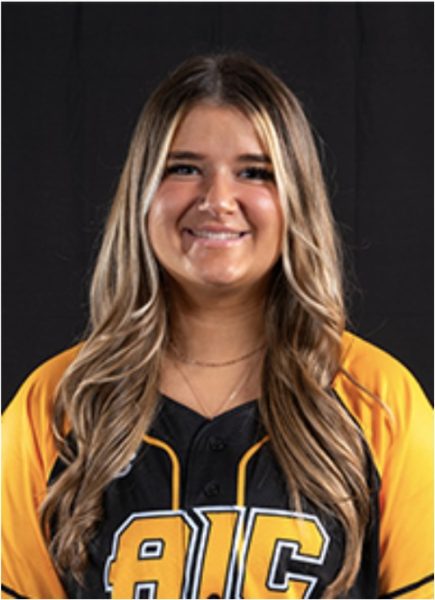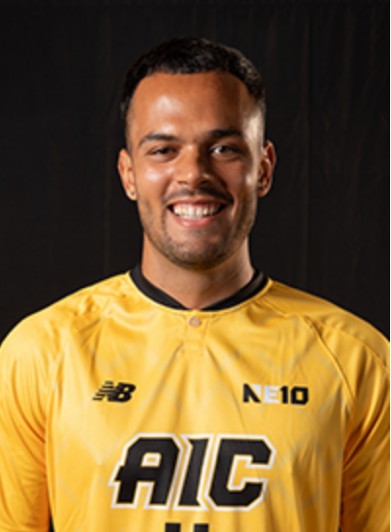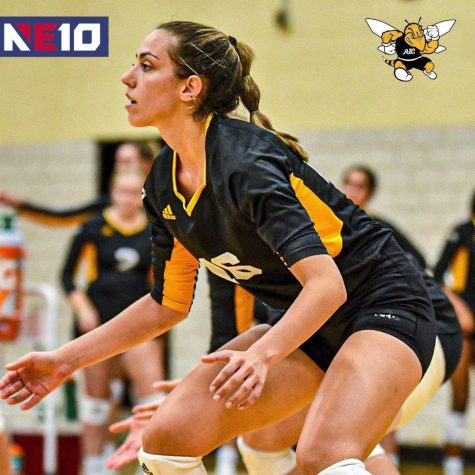MassLive’s Chris Smith on life as a Red Sox beat reporter
MassLive beat reporter Chris Smith visits AIC on Tuesday, October 4.
October 5, 2016
When a 22 year-old Chris Smith threw all of his clothes in his car and drove to Missouri after landing his first job out of college as a high school sports reporter, he certainly didn’t expect to be covering one of baseball’s most storied franchises ten years later.
Smith, now a Boston Red Sox beat reporter for MassLive, visited Professor Patrick Johnson’s Writing for Media class on Tuesday, October 4.
He discussed several topics with the journalism class, from the nature of life on the baseball beat, to the evolution of online journalism, to a heated run-in with Pablo Sandoval.
Having the ability to report to Fenway Park to cover one of the most popular franchises in sports didn’t seem like a realistic possibility for Smith back when he was working 80 hour weeks covering high school sports in Missouri, all while living in a hotel until he could find an apartment.
But that didn’t mean this lifelong baseball fan would give up on his lifelong dream of becoming a baseball reporter.
Smith wrote in a journal in fourth grade that he wanted to be a Major League pitcher. After that, he would become a baseball reporter.
“Obviously the pitching thing didn’t work out because I’m only 5’6,” he joked.
Seeing as the 32 year-old grew up just outside of Boston – in Weymouth, Mass – he was a big fan of the local teams: the Patriots, the Bruins, the Celtics, and of course, the Red Sox.
But that is no longer the case.
“Growing up, the Red Sox were my thing. It’s funny now; because I’m an unbiased reporter, so I’m really not a fan of the Red Sox anymore,” Smith explained. “You have to look at things objectively and criticize the players.”
Smith joined MassLive last April, after his stint in Missouri and a few years at the The Eagle-Tribune, where he began his tenure on the Red Sox beat.
He recalled his first day on the beat – a miserable day for him in which he was just about ready to hang it up after one game.
It was Opening Day 2010, which happened to fall on Easter Sunday. The Red Sox were set to open the season against the New York Yankees that night, an 8 p.m. first pitch.
On Smith’s first day on the beat, he was deathly ill, puking all day.
He was due to work with another writer at his paper at Fenway that night. Smith went to lie down and rest at his family’s house, and was ready to call in sick.
But his co-worker beat him to it, as he texted him saying he was also sick and would not be covering the game – thus, kind of forcing Smith to suck it up and go cover his first Sox game.
“I didn’t get anything in on time, it was a horrible experience,” said Smith.
He was ready to give up after that and stick with high school sports, but his bosses insisted he try again.
“I went into the next series, and I was addicted,” he said.
Addicted to the point where Smith was becoming more and more invested in the Red Sox beat, including showing up at Fenway on his days off.
“I wanted to do as much Red Sox that I would go in to Fenway on my days off, working and not getting paid,” Smith said. “If I was covering a high school game in Lynn, I would cover the game, write the story in my car, and head to Fenway afterwards.”
Now, on a typical day, Smith shows up at 2 p.m. for a 7 p.m. game. He’ll brainstorm some stories for an hour or so, and then head down to the clubhouse at 3:30 p.m. to talk to players and do one on ones. Red Sox Manager John Farrell meets with the media around 4:30 p.m.
After that, he’s writing and posting multiple times all throughout the night, while maintaining a social media presence.
Smith shares the Red Sox duties with co-beat writer Jen McCaffrey. The duo split the road trips during the regular season, but both will be travelling with the team throughout their playoff run.
This past September, the Sox went 19-8 – headlined by an 11 game win streak and the team’s division championship – and played arguably their best baseball of the season down the stretch.
Thanks to the success of the team, MassLive’s Red Sox coverage had a great month.
MassLive had more Red Sox page views than the Boston Herald in September, falling short of only The Boston Globe.
“I look at statistics on page views like every two hours. I’ll look in the middle of dinner with my wife,” Smith said. “I’m obsessed with it.”
How to get those page views? Smith offered some advice to the class on the ins and outs of online journalism these days.
Half the battle is getting readers to your story, which is where headline writing comes in handy. Smith explained “search engine optimization,” which draws the audience to the story via keywords.
Understanding what readers want to read about is just as important as writing an interesting headline.
“You have to understand what the audience wants – that’s the most important thing in journalism,” Smith said. “The angle is important, just find a good story.”
He talked about the evolution of online journalism, where nowadays versatility is key.
Reporters are posting all day, and incorporating multimedia skills (such as video and photography, slideshows, and embedding Tweets into articles).
Asking the right questions is also important – that is, not asking the obvious questions that we already know the answer to.
“The good thing about Boston baseball is second-guessing the manager on everything,” Smith said. “That’s the most important thing; you have to analyze the game – ‘why did you do that? Why didn’t you do that?’ Those are the questions people want to read about.”
Smith advised the class to not be afraid to throw opinion and analysis into stories, before adding that “sometimes, those opinions aren’t going to make the players happy.”
His most infamous run-in with a member of the Red Sox came this year down at Spring Training in Fort Myers, Fla.
Smith wrote an article on Boston’s overweight third baseman Pablo Sandoval. In the story, he wrote about Sandoval’s declining defense, and how he was the worst defender statistically in the MLB in 2015.
He also mentioned that Sandoval showing up to camp out of shape and still overweight was only going to make things worse (the Red Sox claimed Sandoval had lost 20 pounds, but a picture of him fielding with his gut hanging out would suggest otherwise).
“He [Sandoval] is getting paid $95 million guaranteed money,” Smith said. “He’s a pro athlete, you have to be critical of the guy.”

This picture of Pablo Sandoval went viral back in Spring Training.
Apparently the 255-pound Sandoval caught wind of 5’6 Smith’s article, and decided to respond.
Smith was standing around in the locker room, checking emails on his phone, when Sandoval stormed over to Smith, with a bat in hand, whacking the table next to the reporter with his bat.
He tried to talk it over with the third baseman, but received a tirade laced with F-bombs in return, so Smith moved along.
Word got out on the confrontation, and it was the talk of town on the two sports radio stations in Boston (Sandoval was naturally a punching bag at this point due to his poor performance and perceived lack of commitment).
The reporter said that you have to have thick skin to deal with run-ins with players, and you have to be able to handle criticism well.
“I don’t know what it is with sports reporters, but they’re really defensive,” Smith said. “It’s unbelievable. I don’t get defensive at all about anything, really. You can tell me I’m an idiot, or I’m weak, I don’t care.”
There is never a dull moment on the Red Sox beat for Smith, where his days consist of traveling, long hours at the ballpark, brainstorming, lots of social media interaction, writing, self-editing and posting a few stories per day, and maybe the occasional run-in with an angry player.
But in the end, he gets paid to write and opine on his favorite sport, a job many would love to have.
“The job can be stressful at times, but I don’t make it stressful,” Smith said. “It’s not brain surgery. It can be a fun job.”














